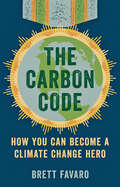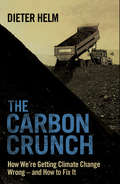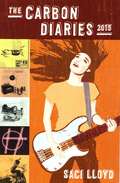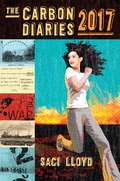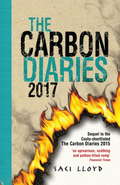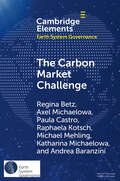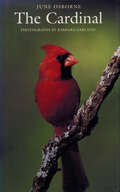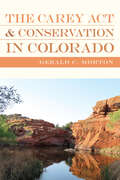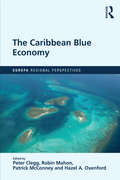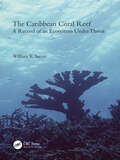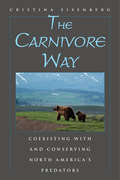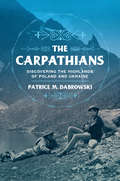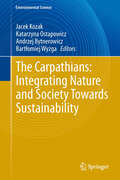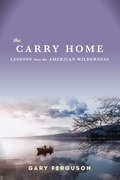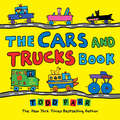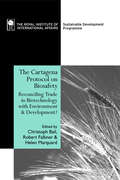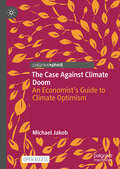- Table View
- List View
The Carbon Code: How You Can Become a Climate Change Hero
by Brett FavaroHow citizens can make realistic, climate-friendly lifestyle changes in a carbon-based economy: “Readable, passionate, and rational.” ?Quarterly Review of BiologyOur world is getting hotter, and it’s our fault—our addiction to fossil fuels is destroying our fragile ecosystems and increasingly wreaking havoc. How can we respond to climate change deniers who mock the fact that environmental activists use fossil fuels? In short, how can an average citizen live a normal, functional life in a carbon-based economy without being justifiably called a hypocrite? In The Carbon Code, conservation biologist Brett Favaro answers these thorny questions, offering simple strategies to help you reduce your carbon footprint—without abandoning common sense.The Carbon Code is based on the four Rs: Reduce, Replace, Refine, and Rehabilitate. After outlining the scientific basics of climate change and explaining the logic of the code he prescribes, the author describes carbon-friendly technologies and behaviors we can adopt in our daily lives. However, he acknowledges that individual action, while vital, is insufficient. To achieve global sustainability, he insists we must make the fight against climate change go viral through conspicuous conservation.The Carbon Code is a tool of empowerment that shows you how to take ownership of your carbon footprint and adopt a lifestyle of conspicuous conservation that will spur governments and corporations to do the same. Saving the planet is, after all, about saving ourselves. The Carbon Code provides a framework to do this, and helps you become a hero in the fight against climate change.“Explains in refreshingly forthright terms how technological advances are making it easier and cheaper to be green.”?Financial Times
The Carbon Control Knob
by Eban Goodstein Richard AlleyOn November 2, 2011, Richard Alley participated in The National Climate Seminar, a series of webinars sponsored by Bard College's Center for Environmental Policy. The online seminars provide a forum for leading scientists, writers, and other experts to talk about critical issues regarding climate change. The series also opens a public conversation, inviting participants to ask questions and contribute their own thoughts. Dr. Alley conducts research on the paleoclimatic record at The Pennsylvania State University in order to understand the history, and perhaps the future, of climate change. In his lecture, Alley gave a concise overview of why we know what we know about climate change, and what that evidence can tell us about today's warming planet. Alley not only provides an accessible science lesson, but reveals his own greatest concerns about climate change and offers advice to those who want to stop debating the subtleties of climate science and act now. This E-ssential is an edited version of Alley's talk and the subsequent question and answer session. While some material has been cut and some language modified for clarity, the intention was to retain the substance of the original discussion.
The Carbon Crunch: How We're Getting Climate Change Wrong—and How to Fix It
by Dieter HelmAn economist&’s take on &“why the world&’s efforts to curb the carbon dioxide emissions behind global warming have gone so wrong, and how it can do better&” (Financial Times). Despite commitments to renewable energy and two decades of international negotiations, global emissions continue to rise. Coal, the most damaging of all fossil fuels, has actually risen from 25% to almost 30% of world energy use. And while European countries congratulate themselves on reducing emissions, they&’ve increased their carbon imports from China and other developing nations, who continue to expand their coal use. As standards of living improve in developing countries, coal use can only increase as well—and global temperatures along with it. Written by an Oxford economist who specializes in environmental issues, this book goes beyond pieties and pipe dreams to address the practical realities that are preventing us from making progress on this crucial issue—and what we can do differently before it&’s too late. &“Should be compulsory reading for the entire political class as well as the bureaucratic elite and the commentariat.&”—New Statesman &“An optimistically levelheaded book about actually dealing with global warming.&”—Kirkus Reviews (starred review) &“A powerful and heartfelt plea for hard-nosed realism.&”—New Scientist
The Carbon Diaries 2015
by Saci LloydIt's the year 2015, a time when global warning has begun to ravage the environment. In response, the United Kingdom becomes the first country to mandate carbon rationing -- a well-intentioned plan that goes tragically awry. This story of one girl's attempt to stay grounded in a world where disaster has become the norm is told in short diary entries.
The Carbon Diaries 2015
by Saci LloydIt's the year 2015, and global warming is ravaging the environment. In response, the United Kingdom mandates carbon rationing. <P><P>When her carbon debit card arrives in the mail, sixteen-year-old Laura is just trying to handle the pressure of exams, keep her straight-X punk band on track, and catch the attention of her gorgeous classmate Ravi. <P><P>But as multiple natural disasters strike and Laura's parents head toward divorce, her world spirals out of control. <P><P>With the highest-category hurricane in history heading straight toward London, chronicling the daily insanity is all Laura can do to stay grounded in a world where disaster is the norm.
The Carbon Diaries 2015: Book 1
by Saci LloydIt's January 1st, 2015, and the UK is the first nation to introduce carbon dioxide rationing, in a drastic bid to combat climate change. As her family spirals out of control, Laura Brown chronicles the first year of rationing with scathing abandon. Will her mother become one with her inner wolf? Will her sister give up her weekends in Ibiza? Does her father love the pig more than her? Can her band The Dirty Angels make it big? And will Ravi Datta ever notice her? In these dark days, Laura deals with the issues that really matter: love, floods and pigs. The Carbon Diaries 2015 is one girl's drastic bid to stay sane in a world unravelling at the seams.
The Carbon Diaries 2015: Book 1 (Carbon Diaries)
by Saci LloydIt's January 1st, 2015, and the UK is the first nation to introduce carbon dioxide rationing, in a drastic bid to combat climate change. As her family spirals out of control, Laura Brown chronicles the first year of rationing with scathing abandon. Will her mother become one with her inner wolf? Will her sister give up her weekends in Ibiza? Does her father love the pig more than her? Can her band The Dirty Angels make it big? And will Ravi Datta ever notice her? In these dark days, Laura deals with the issues that really matter: love, floods and pigs. The Carbon Diaries 2015 is one girl's drastic bid to stay sane in a world unravelling at the seams.
The Carbon Diaries 2017
by Saci LloydIn this riveting sequel to the hit eco-thriller The Carbon Diaries 2015, Laura Brown, now a college student in London, chronicles the struggle England faces as the government tightens its grip on carbon rations. As perceptive and compulsively readable as its prequel, this book raises provocative moral questions for today's young adults.
The Carbon Diaries 2017: Book 2
by Saci LloydIt's over a year since her last diary and Laura Brown is now in her first year of university in London, a city still struggling to pull itself together in the new rationing era. Laura's right in the heart of it; her band, the dirty angels, are gigging all over town until a police crackdown on rioting students forces them out of the city. After a brief exile on her parents' farm, the angels set off in a battered VW bus on a tour of Europe with the fabulous Tiny Chainsaws in the Distance.The tour soon unravels, however, in an increasingly dramatic sequence of events that include drought in Europe and Africa, a tidal-wave of desperate immigrants, a water war in the Middle East and a city-wide face off with the army in London. Not to mention infidelity, betrayal, friendship, love and massive courage.How long can Laura distance herself from the struggle? And more importantly, how can she keep her style and hope alive in a world on the edge of madness?
The Carbon Diaries 2017: Book 2
by Saci LloydIt's over a year since her last diary and Laura Brown is now in her first year of university in London, a city still struggling to pull itself together in the new rationing era. Laura's right in the heart of it; her band, the dirty angels, are gigging all over town until a police crackdown on rioting students forces them out of the city. After a brief exile on her parents' farm, the angels set off in a battered VW bus on a tour of Europe with the fabulous Tiny Chainsaws in the Distance.The tour soon unravels, however, in an increasingly dramatic sequence of events that include drought in Europe and Africa, a tidal-wave of desperate immigrants, a water war in the Middle East and a city-wide face off with the army in London. Not to mention infidelity, betrayal, friendship, love and massive courage.How long can Laura distance herself from the struggle? And more importantly, how can she keep her style and hope alive in a world on the edge of madness?
The Carbon Farming Solution: A Global Toolkit of Perennial Crops and Regenerative Agriculture Practices for Climate Change Mitigation and Food Security
by Eric ToensmeierWith carbon farming, agriculture ceases to be part of the climate problem and becomes a critical part of the solution&“This book is the toolkit for making the soil itself a sponge for carbon. It&’s a powerful vision.&”—Bill McKibben&“The Carbon Farming Solution is a book we will look back upon decades from now and wonder why something so critically relevant could have been so overlooked until that time. . . . [It] describes the foundation of the future of civilization.&”—Paul HawkenIn this groundbreaking book, Eric Toensmeier argues that agriculture—specifically, the subset of practices known as &“carbon farming&”—can, and should be, a linchpin of a global climate solutions platform. Carbon farming is a suite of agricultural practices and crops that sequester carbon in the soil and in above-ground biomass. Combined with a massive reduction in fossil fuel emissions—and in concert with adaptation strategies to our changing environment— carbon farming has the potential to bring us back from the brink of disaster and return our atmosphere to the &“magic number&” of 350 parts per million of carbon dioxide. Toensmeier&’s book is the first to bring together these powerful strategies in one place.Includes in-depth analysis of the available research.Carbon farming can take many forms. The simplest practices involve modifications to annual crop production. Although many of these modifications have relatively low sequestration potential, they are widely applicable and easily adopted, and thus have excellent potential to mitigate climate change if practiced on a global scale. Likewise, grazing systems such as silvopasture are easily replicable, don&’t require significant changes to human diet, and—given the amount of agricultural land worldwide that is devoted to pasture—can be important strategies in the carbon farming arsenal. But by far, agroforestry practices and perennial crops present the best opportunities for sequestration. While many of these systems are challenging to establish and manage, and would require us to change our diets to new and largely unfamiliar perennial crops, they also offer huge potential that has been almost entirely ignored by climate crusaders. Many of these carbon farming practices are already implemented globally on a scale of millions of hectares. These are not minor or marginal efforts, but win-win solutions that provide food, fodder, and feedstocks while fostering community self-reliance, creating jobs, protecting biodiversity, and repairing degraded land—all while sequestering carbon, reducing emissions, and ultimately contributing to a climate that will remain amenable to human civilization. Just as importantly to a livable future, these crops and practices can contribute to broader social goals such as women&’s empowerment, food sovereignty, and climate justice. The Carbon Farming Solution is—at its root—a toolkit and the most complete collection of climate-friendly crops and practices currently available.With this toolkit, farmers, communities, and governments large and small, can successfully launch carbon farming projects with the most appropriate crops and practices to their climate, locale, and socioeconomic needs. Toensmeier&’s ultimate goal is to place carbon farming firmly in the center of the climate solutions platform, alongside clean solar and wind energy. With The Carbon Farming Solution, Toensmeier wants to change the discussion, impact policy decisions, and steer mitigation funds to the research, projects, and people around the world who envision a future where agriculture becomes the protagonist in this fraught, urgent, and unprecedented drama of our time. Citizens, farmers, and funders will be inspired to use the tools presented in this important book to transform degraded lands around the world into
The Carbon Footprint Handbook
by Subramanian Senthilkannan MuthuThorough and detailed, The Carbon Footprint Handbook encompasses all areas of carbon footprint, including the scientific elements, methodological and technological aspects, standards, industrial case studies, and communication of carbon footprint results. Written and edited by an international group of experts, the far-ranging topics on carbon foot
The Carbon Market Challenge: Preventing Abuse Through Effective Governance (Elements in Earth System Governance)
by Michael Mehling Paula Castro Axel Michaelowa Regina Betz Andrea Baranzini Raphaela Kotsch Katharina MichaelowaCarbon markets – both emission trading systems and baseline and credit systems – are an increasingly common policy instrument being introduced to address climate change mitigation. However, their design is crucial to ensure that they deliver cost-effective emission reductions while maintaining environmental integrity. This Element puts together a comprehensive, principle-based overview of the risks and abuses to environmental integrity and cost effectiveness that have emerged for carbon markets at all jurisdictional levels around the world, provides concrete examples, and offers effective policy and governance solutions to overcome such risks. This title is also available as Open Access on Cambridge Core.
The Cardinal (Corrie Herring Hooks Series)
by June OsborneIn this inviting guide, June Osborne and Barbara Garland follow a year in the life of the Northern Cardinal with a fact-filled text and glowing color photographs. They describe how cardinals stake out territory and choose mates, find a nesting site and incubate their eggs, feed the young and prepare them for full-fledged independence. The Cardinal also explores the special relationship that humans have with their favorite redbirds. Osborne traces the symbolic use of cardinals as state birds (Illinois, Indiana, Kentucky, North Carolina, Ohio, Virginia, and West Virginia) and athletic mascots and shows how they appear on everything from postage stamps to Christmas cards, as well as in fine art, literature, and Native American folklore.
The Carey Act and Conservation in Colorado
by Gerald C. MortonThe Carey Act and Conservation in Colorado is an environmental history of the endless missteps and unforeseen consequences that characterized Colorado’s participation in the Carey Act—an 1894 federal law that granted one million acres of desert-classified public land to each western state for private irrigation development and settlement. In this inclusive narrative, author Gerald Morton reveals how this obscure law affected thirty-four of Colorado’s most arid stretches of landscape. Morton contextualizes the Carey Act’s significance in Colorado through a study of the Two Buttes and Muddy Creek projects in the state’s southeastern corner—tragic examples of the disconnect among developers seeking windfall profits in the face of financial rollercoasters, the challenge of reclaiming remote sagebrush country, and settlers seeking viable livelihoods that eventually led conservationists to reimagine the failures as public wildlife refuges. A collision of values between developers and settlers lay at the center of those wildlife habitat conservation efforts, forcing people to rethink their relationship with the land and ephemeral streams—an awareness that correlated with the advent of modern ecology. The Carey Act and Conservation in Colorado is the untold story of the manipulation of nature and the reconceived use of land for public wildlife areas on the southern plains of the American West. Offering original research on arid lands policy, federal and state agency oversight, irrigation bond financing, heartbroken settlers’ grievances, individual developers’ motives, and the rise of wildlife conservation, this compelling tale of misfortune will appeal to scholars and general readers interested in conservationist and environmental history in the American West.
The Caribbean Blue Economy (Europa Regional Perspectives)
by Peter Clegg, Robin Mahon, Patrick McConney and Hazel A. OxenfordThe Blue Economy is emerging on the global scene as a powerful and persuasive new concept for sustainable development based on economic activities associated with the ocean. Several regions globally have adopted this concept at national and regional levels, including the Caribbean. Given the complex, multisectoral and multilevel nature of the Blue Economy, it is clear that different approaches will be needed for different regions. Hence, this volume explores the opportunities, threats and risks involved in operationalising the Blue Economy in the Wider Caribbean Region, defined as northern Brazil to the USA and all mainland and island countries and territories in-between. The first part of the book looks at where the region stands in the global picture regarding adoption of the Blue Economy and what is planned. The second set of chapters examines key crosscutting issues such as ecosystem services, climate change and governance at national and regional levels that could make or break the Blue Economy initiative. The book then goes on to explore the main sectoral activities that will constitute the Blue Economies in the region: fisheries, tourism, shipping and transport, renewable energy, oil and gas, seabed mining and waste management are all considered. The book ends with a synthesis of the political and technical requirements to overcome threats and take advantage of opportunities in the Blue Economy.
The Caribbean Coral Reef: A Record of an Ecosystem Under Threat
by William K. SaccoThis book is a visual tour of Caribbean coral reefs between 1968 and 1978. They are the world’s second largest coral reef community and the most threatened. The Caribbean Coral Reef: A Record of an Ecosystem Under Threat offers a priceless historical record made by a photographer who set out to document the major reef species when those reefs were at their prime. Today, coral reefs are under threat as never before and, sadly, most of what is shown in the book's photographs is now gone forever. It is only by comparing the images in this book with what we see now that we are able to fully recognize what we have lost. With its stunning photography and precise, accurate scientific information, this book offers students of coral reefs a wealth of information about this rich, fragile ecosystem. It is also written accessibly for non-academic visitors to the Caribbean reef or anyone interested in the earth’s creatures. Many of the invertebrates will be unfamiliar to most people, and the author reveals fascinating insights into these otherworldly creatures and their lifestyles. Enjoy this field guide to the reefs that were, and savor the beauty of this vanishing environment and its organisms.
The Carnivore Way: Coexisting with and Conserving North America's Predators
by Cristina EisenbergWhat would it be like to live in a world with no predators roaming our landscapes? Would their elimination, which humans have sought with ever greater urgency in recent times, bring about a pastoral, peaceful human civilization? Or in fact is their existence critical to our own, and do we need to be doing more to assure their health and the health of the landscapes they need to thrive? In The Carnivore Way, Cristina Eisenberg argues compellingly for the necessity of top predators in large, undisturbed landscapes, and how a continental-long corridor--carnivore way--provides the room they need to roam and connected landscapes that allow them to disperse. Eisenberg follows the footsteps of six large carnivores--wolves, grizzly bears, lynx, jaguars, wolverines, and cougars--on a 7,500-mile wildlife corridor from Alaska to Mexico along the Rocky Mountains. Backed by robust science, she shows how their well-being is a critical factor in sustaining healthy landscapes and how it is possible for humans and large carnivores to coexist peacefully and even to thrive. University students in natural resource science programs, resource managers, conservation organizations, and anyone curious about carnivore ecology and management in a changing world will find a thoughtful guide to large carnivore conservation that dispels long-held myths about their ecology and contributions to healthy, resilient landscapes.
The Carpathians: Discovering the Highlands of Poland and Ukraine (NIU Series in Slavic, East European, and Eurasian Studies)
by Patrice M. DabrowskiIn The Carpathians, Patrice M. Dabrowski narrates how three highland ranges of the mountain system found in present-day Poland, Slovakia, and Ukraine were discovered for a broader regional public. This is a story of how the Tatras, Eastern Carpathians, and Bieszczady Mountains went from being terra incognita to becoming the popular tourist destinations they are today. It is a story of the encounter of Polish and Ukrainian lowlanders with the wild, sublime highlands and with the indigenous highlanders—Górale, Hutsuls, Boikos, and Lemkos—and how these peoples were incorporated into a national narrative as the territories were transformed into a native/national landscape.The set of microhistories in this book occur from about 1860 to 1980, a time in which nations and states concerned themselves with the "frontier at the edge." Discoverers not only became enthralled with what were perceived as their own highlands but also availed themselves of the mountains as places to work out answers to the burning questions of the day. Each discovery led to a surge in mountain tourism and interest in the mountains and their indigenous highlanders.Although these mountains, essentially a continuation of the Alps, are Central and Eastern Europe's most prominent physical feature, politically they are peripheral. The Carpathians is the first book to deal with the northern slopes in such a way, showing how these discoveries had a direct impact on the various nation-building, state-building, and modernization projects. Dabrowski's history incorporates a unique blend of environmental history, borderlands studies, and the history of tourism and leisure.
The Carpathians: Integrating Nature and Society Towards Sustainability
by Bartłomiej Wyżga Andrzej Bytnerowicz Jacek Kozak Katarzyna OstapowiczThe book includes a broad spectrum of perspectives from different scientific disciplines (both the natural and social sciences) as well as practical knowledge. It gives a new insight into the Carpathian mountain region
The Carry Home: Lessons from the American Wilderness
by Gary FergusonThe nature writing of Gary Ferguson arises out of intimate experience. He trekked 500 miles through Yellowstone to write Walking Down the Wild and spent a season in the field at a wilderness therapy program for Shouting at the Sky. He journeyed 250 miles on foot for Hawks Rest and followed through the seasons the first fourteen wolves released into Yellowstone National Park for The Yellowstone Wolves. But nothing could prepare him for the experience he details in his new book.The Carry Home is both a moving celebration of the outdoor life shared between Ferguson and his wife Jane, who died tragically in a canoeing accident in northern Ontario in 2005, and a chronicle of the mending, uplifting power of nature. Confronting his unthinkable loss, Ferguson set out to fulfill Jane's final wish: the scattering of her ashes in five remote, wild locations they loved and shared. The act of the carry home allows Ferguson the opportunity to ruminate on their life together as well as explore deeply the impactful presence of nature in all of our lives.Theirs was a love borne of wild places, and The Carry Home offers a powerful glimpse into how the natural world can be a critical prompt for moving through cycles of immeasurable grief, how bereavement can turn to wonder, and how one man rediscovered himself in the process of saying goodbye.
The Cars and Trucks Book
by Todd ParrFrom bestselling and beloved author Todd Parr, a new book about all of the different ways that cars and trucks help people and have fun. Some trucks help on the farm. Some trucks help in the city. Some cars like to drive in the snow. And some cars like to drive to the beach. All cars and trucks LOVE to be on the ROAD!Todd Parr brings his trademark bright colors and bold lines to his new book about cars, trucks, and the occasional bus. In a fun collection of silly images, Todd explores all of the ways vehicles have an impact on our daily lives, while weaving in messages about positivity, the environment, and safety. Readers will laugh along with the whole four-wheeled gang!
The Cartagena Protocol on Biosafety: Reconciling Trade in Biotechnology with Environment and Development
by Robert Falkner Christoph Bail Helen MarquardModern biotechnology - the controversial manipulation of genes in living organisms - has far-reaching implications for agriculture, human health, trade and the environment. Against the odds, an international treaty governing biosafety and trade in biotechnology was adopted in 2000. The Cartagena Protocol on Biosafety of the Convention on Biological Diversity deals with one of the most important and challenging issues thrown up by developments in biotechnology. This volume is a comprehensive review of the protocol and the process that led to its adoption. It includes contributions from many of the key players involved and analyses the commercial and political interests at stake, the operations and implications of the protocol, and prospects for the future.
The Case Against Climate Doom: An Economist’s Guide to Climate Optimism
by Michael JakobBy highlighting the social, political and technological progress already made, this open access book presents an optimistic outlook for a transition to a climate-neutral world and successful adaptation to climate change. With a focus on economics and policy, it covers a wide range of cases where climate action is heading in the right direction. Short digestible chapters highlight, among other things, growing awareness among the general population and the willingness to act, and present technologies and policy measures that have already led to emission reductions. Particular attention is given to the economic opportunities of green technologies, the rapid spread of renewable energy and storage technologies, the decarbonization of industry, net-zero targets, climate legislation adopted in many countries, and carbon pricing.
